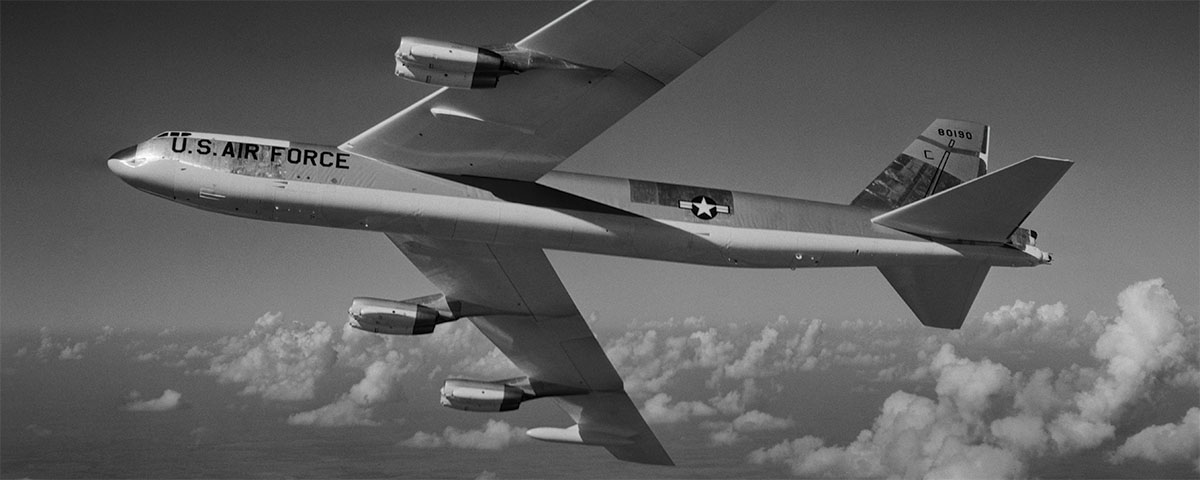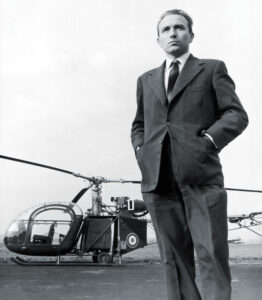In one of America’s worst “Broken Arrow” incidents, a B-52 carrying four hydrogen bombs crashed on the ice off Greenland.
Major Alfred D’Amario thought the worst was over after his violent ejection from the dark and smoky cockpit of his Boeing B-52G Stratofortress. The bomber he had abandoned was diving in flames toward the nearby ice-covered Bylot Sound off Thule Air Force Base in northwestern Greenland. D’Amario knew that the one-point safe bombs would not go “nuclear” in a crash. As he descended, the major sighted an orange fireball eight miles to the west. Suddenly, an intensely bright white light outshone the orange jet fuel blaze as the high explosives in four hydrogen bombs in the bomb bay detonated from the shock of impact. A supersonic blast wave tore outward in all directions into the subfreezing arctic air. In several seconds, D’Amario’s easy downward drift was interrupted. As he recounted in his book Hangar Flying: “I watched it [the bright light] for a few seconds and, suddenly, all Hell broke loose. My parachute and the life raft both took off to my right leaving me what looked like ten or fifteen feet to the left of them. Then, I started swinging back and forth between them.” D’Amario and five of his fellow crewmen made it safely to the ground. One crew member did not. Thus began one of the U.S. Air Force Strategic Air Command’s worst “Broken Arrow” nuclear incidents of the Cold War.
As the Cold War evolved, SAC developed technologies to detect and counter a Soviet surprise nuclear attack. When SAC deployed the first intercontinental ballistic missiles in 1959, its primary detection and strike force consisted of the Defense Early Warning line of radars, several Ballistic Missile Early Warning Systems (BMEWS) and dozens of B-52 bombers armed with thermonuclear weapons. General Thomas S. Power, commander of SAC, initiated several alert programs to reduce the response time for bombers to take off and make their runs into the Soviet Union. In 1958 SAC B-52s began flying “Chrome Dome” missions, which took the crews through an arctic route close to the Soviet border. In the fall of 1960, the $500 million BMEWS facility at Thule AFB began operations, its data sent by undersea cables, and later wirelessly, to the North American Aerospace Defense Command. Concerned that Thule “blackouts” could indicate that the facility either had been hit by the Soviets or had experienced a benign technical failure, in August 1961 SAC began secret “Hard Head” Thule monitoring missions to maintain constant visual surveillance. These 24-hour missions had crews flying in a “butter knife” holding pattern, similar to a figure 8, at 35,000 feet near the air base. The bombers were fully armed, and the crew had all the mission planning documents they required to strike the Soviet Union.
By 1968 SAC had assigned its 380th Strategic Bombardment Wing at Plattsburgh AFB to the Hard Head missions. Near the Canadian border and encompassing the 528th Bombardment Squadron, the wing fielded the latest B-52G models.
January 21 was a bright and clear Sunday morning in northern New York as a refreshed crew of the 380th prepared to take their craft aloft to Thule on a mission coded Junky 14, call sign Hobo 28. Captain John Haug, the pilot and commander, took his crew of six out to the flight line to begin preflight checks and loading. Captain Leonard Svitenko, copilot, was his right-seater. Also on the top deck of the cockpit, facing backward, were the electronic weapons officer (EWO), Captain Richard Marx, and aerial gunner Staff Sgt. Calvin Waldrep Snapp. (Unlike on earlier B-52s, the G model repositioned the tail gunner in the cockpit.) Manning the “Black Hole” on the lower deck were radar-navigator/bombardier Major Frank Hopkins and Captain Curtis R. Criss, who was assigned that day to substitute for the normally scheduled navigator. The mission to Thule and back would exceed 24 hours, and regulations thus required a third pilot onboard. That role fell to Major D’Amario, the safety officer from the wing’s headquarters.
On the flight line, Haug’s initially assigned B-52 had instrumentation problems, so the crew moved on to tail number 58-0188, which was fully fueled and armed. Hard Head missions were long and cold, requiring extra supplies. Along with the crew’s A-3 personal flight bags, the ground crew quickly loaded the aircraft with food lockers, a sleeping bunk and an electric oven. Since these long flights also tested the crew’s derrières, D’Amario loaded three polyurethane cushions under the fold-away jump seat on the lower deck, located adjacent to the rear bulkhead door to the electric power supply deck and the wheel wells of the massive front landing gear. When not in use, this seat could be flipped upward against the bulkhead. On this flight, D’Amario later added a fourth cushion to the pile and moved a metal food locker against it to prop up his feet.
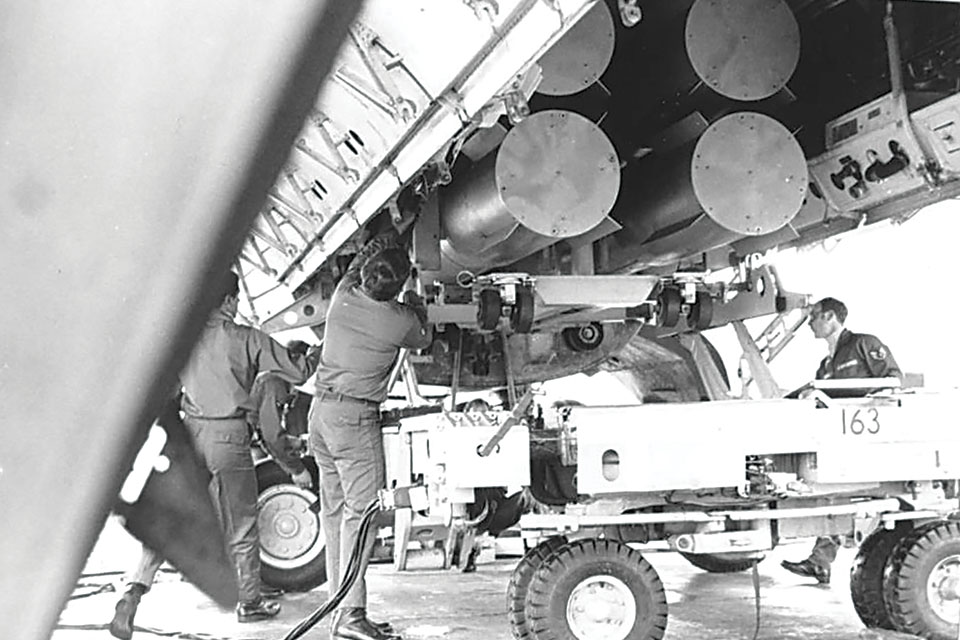
Arctic weather stressed the B-52 heating system. As D’Amario pointed out, “At maximum endurance throttle settings, the heating and air conditioning system cannot deliver enough heat to keep the cockpit warm.” Flight crews had a method for handling this. Early on, the copilot applied the normal heating and air conditioning system. As the cockpit became colder, he reached down to a control panel adjacent to his right calf and gradually turned the heat up to maximum. When this “normal” system could not maintain sufficient cockpit heat, the copilot moved to the center console to switch on the engine air bleed system. The final compressor stages of all eight jet engines forced 750-degree air into 4-inch pipes at 250 pounds per square inch. Some of this hot air was routed into manifolds designed to cool it down for heating the cockpit. At optimum cockpit heat, the copilot would pull back on the air bleed until switching back to the normal system. The whole cycle would then start over again. This superheated air also drove the electrical alternators, maintained cabin pressure and powered other vital equipment.
Boeing detailed little in its B-52 flight manual regarding the heating potential of the air bleed system. One crew later reported that a flight jacket had almost caught fire while resting against a heating vent. Another account described the stink of burned dust in vent pipes after a bomber had sat idle in a maintenance depot. In other cases, superheated air released from damaged air bleed pipes had destroyed onboard equipment and almost cooked off the weapons in the bomb bay.
Prior to takeoff, Haug’s crew checked the condition of their primary payload, four B28FI thermonuclear weapons, the only model that SAC bombers carried in 1968. The FI, or “Full Fuzing Internal” model, allowed the radar-navigator to set the weapon for either an air burst, retarded air burst, ground burst or a parachute-retarded laydown. The 12-foot-long, 22-inch-diameter, 2,300-pound Mod 5 H-bombs on board had yields of up to 1.45 megatons, enough to obliterate a city and its suburbs. The ground crew clipped four of these weapons as a quad onto a cradle in the forward part of the B-52’s cavernous bomb bay.
Hobo 28’s takeoff and five-hour flight to the Thule area were relatively uneventful. Prior to entering its 100-mile-long butter knife flight pattern, the crew rendezvoused with a KC-135 to top off their fuel tanks. After refueling, D’Amario gave copilot Svitenko a break for a snack and a nap on the bunk.
As Hobo 28 settled into its flight pattern, Haug and D’Amario reduced the throttles for maximum endurance and leveled off at an altitude just above 30,000 feet. The minus-55-degree outside air penetrated the thinly insulated crew cabin, causing the interior temperature to drop precipitously. From the lower deck, Svitenko requested more heat, and D’Amario began the cabin heating process, quickly maximizing the normal heating system. He then brought in hot air from the air bleed manifolds. Several minutes into that cycle were all that was necessary to create the flight’s subsequent emergency.
The B-52 heating distribution system consisted of a series of pipes with round holes punched through them in regular intervals. One of these pipes ran into a vent box positioned directly beneath the jump seat. Superheated air pushed upward against the four stowed polyurethane cushions. Considered “solid gasoline” by fire marshals, heated polyurethane will first begin to smolder, generating characteristic white smoke and toxic combustible gases, before further breaking down and igniting at somewhere above 600 degrees.
The pilots on the upper deck didn’t understand why they were sweltering while the lower deck remained cold. Accounts vary on who did what, but clearly Svitenko was on break and available to respond to the emergency. Some report Criss as searching for and finding the fire, but this interpretation may be a result of his staying in his seat initially and updating the pilot via intercom. Hopkins most likely stayed focused on the instruments monitoring the nuclear weapons.
At 4:22 p.m. local time, 90 miles south of Thule AFB, Marx smelled burning rubber, and some of the crew began a scramble to find the source. Spotting smoke coming from under the jump seat, Marx first expended the lower-deck A-20 fire extinguisher around the seat, to no effect. He then retrieved the second and last extinguisher from between the EWO and gunner positions on the upper deck, and emptied it onto the rear bulkhead. As the polyurethane smoldered, burned and disintegrated, pieces of it most likely fell down into the vent box below the cushions, making it impossible for the crew to reach the fire itself. Even then, burning polyurethane is best extinguished with water, carbon dioxide or dry powdered chemicals, none of which were available to the crew.
As the smoke continued to pour, Svitenko pulled the metal food box away from the seat, and flames erupted from the stowed cushions. Both levels of the cabin soon filled with dense white smoke. Criss called into the pilot that they couldn’t control the fire and the lower deck was becoming engulfed. With fire temperatures probably exceeding 1,400 degrees, Criss made a last desperate, futile attempt to smother the fire with a flight bag. Marx climbed to the upper deck and opened the sextant port on the ceiling directly above the ladder to clear the cockpit of smoke.
Haug ordered everyone on oxygen, turned the bomber northward toward Thule and began descending rapidly while D’Amario called in the emergency. Minutes later, at 19,000 feet, the aircraft lost all power, and its instruments went dark. D’Amario worked feverishly to bring the alternators back online as the fire continued to ravage these systems on the lower deck. In the arctic darkness and dense smoke of the cockpit, only the lights of Thule AFB ahead guided the pilots. Haug continued to reduce altitude to prepare for a potential bailout. As they approached the base, Criss reported that the fire down below was now intolerable, and Haug ordered the bailout at 4:37 p.m.
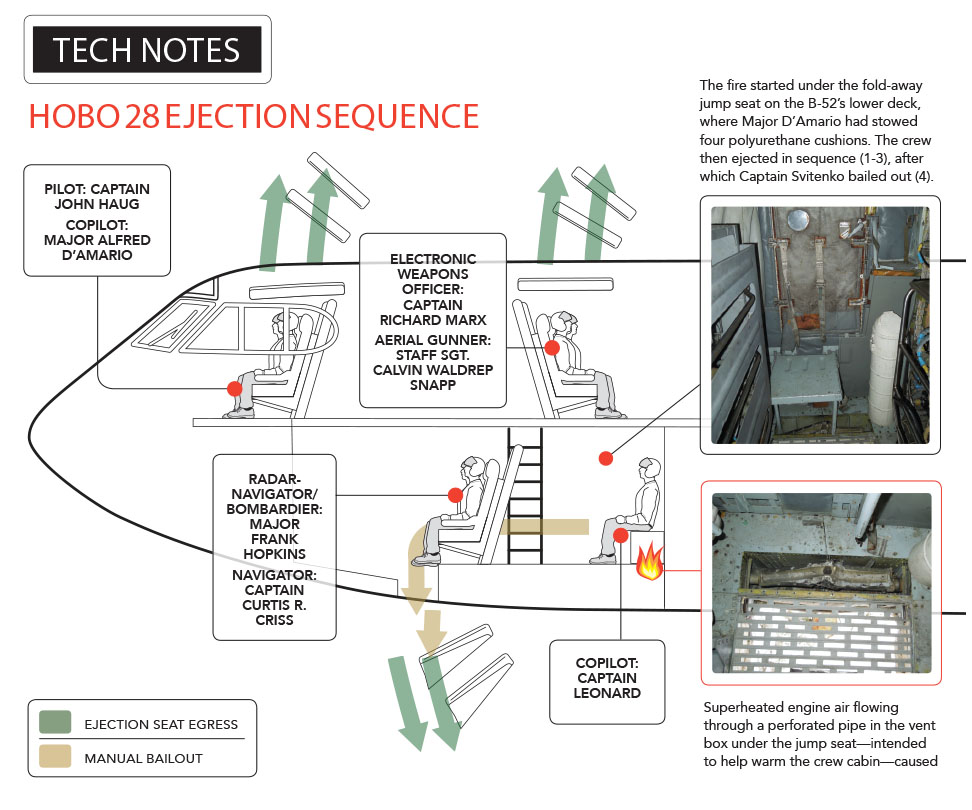
With everyone at their stations ready to eject and D’Amario in the copilot seat, it’s likely Svitenko down below strapped on his parachute while trying to smother the fire with what little resources he had left. His manual bailout route would have been through the navigator’s open floor hatch left by the ejecting crewman. Thule radar later reported that the men left the bomber at 8,000 feet while traveling 690 mph. From the blazing Black Hole, Criss ejected first, and then Hopkins. Marx and Snapp followed. Haug and D’Amario gave Svitenko as much time as possible before they left the plane in their Weber seats.
Manually bailing out of a B-52 is considered unsafe above 316 mph. Svitenko had to endure flames and smoke to jump through the hatch. He did not survive. At some point during his exit into the slipstream, he struck his head on the hatch edge or the electronic countermeasures antennas on the bottom of the fuselage. When the rescue teams found him far north of the air base, part of the nylon of his unopened parachute pack was melted and fused. The fire also appeared to have melted parts of his boot soles. Most accounts report he was not conscious during the fall.
No one escaped injury. Between the bomber’s speed at ejection and their impacts onto the ice, most of the crew suffered cuts, bruises, and strained ligaments and tendons. Hopkins’ immediate injuries were the worst, with fractures to his left arm and shoulder. Danish and Air Force personnel retrieved the crew from the south side of Thule, though Criss and Svitenko were missing. Criss had landed on the opposite side of a small mountain, which blocked his view of the base. With no identifiable exit route in the pitch dark, he rolled up in his parachute inside his inflatable raft and waited in the subfreezing arctic cold. Rescue teams found him 21 hours later, severely frostbitten but alive, to the utter disbelief of the local Inuits, who assumed he must have succumbed to the cold. Criss later lost both feet to frostbite.
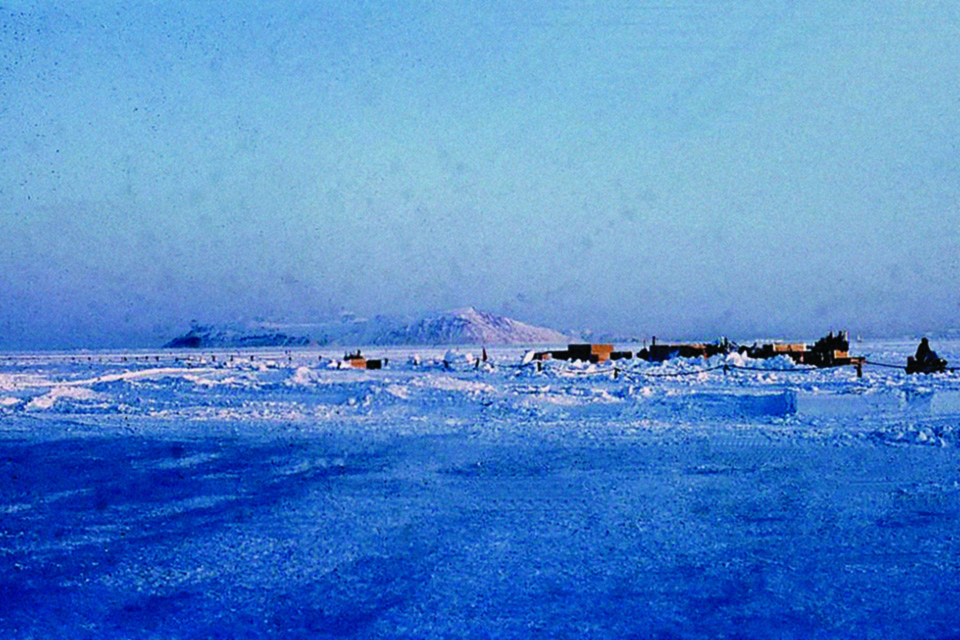
During its final two unpiloted minutes, Hobo 28 flew another 18 to 23 miles. The burning bomber continued north over the base and made a 180-degree left turn over Wholstenholme Fjord, while quickly losing altitude. As it headed southwest for Bylot Sound at 700 mph, buffeting turbulence caused the aircraft to shed a bomb bay door. Around 4:40 p.m., in a steep 50- to 60-degree bank, the left wing struck the ice about eight miles west of the air base, carved a trench and began to disintegrate and separate from the fuselage, its engines cartwheeling south. The nose and front fuselage impacted hard with a shallow 15- to 20-degree belly flop and shattered a 160-foot-diameter swath of thick sea ice. While 100-plus tons of JP-4 fuel spewed and exploded forward of the point of impact, ice and fuselage debris crushed the four nuclear weapons in the bomb bay. The high explosives surrounding the plutonium/highly enriched uranium cores immediately detonated with a bright white light, further shredding the bomber and blowing plutonium and uranium dust, tritium gas and secondary components downrange. The one-point safe H-bombs produced no nuclear yield.
For the next five to six hours, the flames from the jet fuel rose to almost a half-mile, and the smoke column extended thousands of feet higher. Much of the aircraft debris sank in the 600-foot-deep water before the shattered blocks of ice at the point of impact refroze. The conflagration created a blackened scar of ice about a tenth of a mile wide and almost a half-mile long, with debris scattered in a 1-by-3-mile area.
Back at base operations, the major in charge had difficulty determining the B-52’s payload because D’Amario would neither confirm nor deny the presence of nuclear weapons. Finally, when asked whether rescue teams could approach the crash site safely, D’Amario responded, “Major, I wouldn’t go within 3,000 feet of that SOB.”
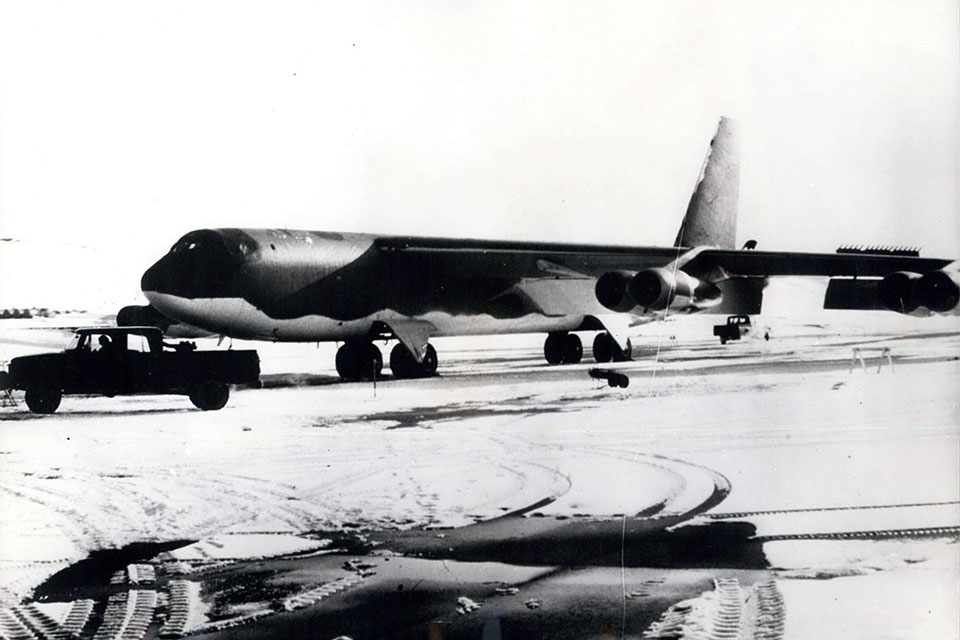
The next day, still in the arctic winter darkness, volunteer Inuit mushers drove dogsleds across the sea ice carrying a seven-man survey team. They returned to report the presence at the crash site of only small pieces of the airplane on the ice, though recovery crews later found six of the engines downrange. To their dismay, their radiation detectors had quickly become inoperative in the bitter cold. Nonetheless, the black-stained area extending south from the broken and refrozen point of impact was notably radioactive.
SAC immediately activated the Broken Arrow Control Group, and assigned Major General Richard O. Hunziker to Project Crested Ice. Construction of “Camp Hunziker” on the ice began the next day. To prevent breaking through the ice, cleanup crews dispersed their temporary buildings, storage piles and heavy earthmovers. Stormy weather on the 24th and 28th blew plutonium and uranium dust at least four miles northwest to Saunders Island. Within days, the Air Force, Atomic Energy Commission and two national laboratories were assisting with the crash site cleanup.
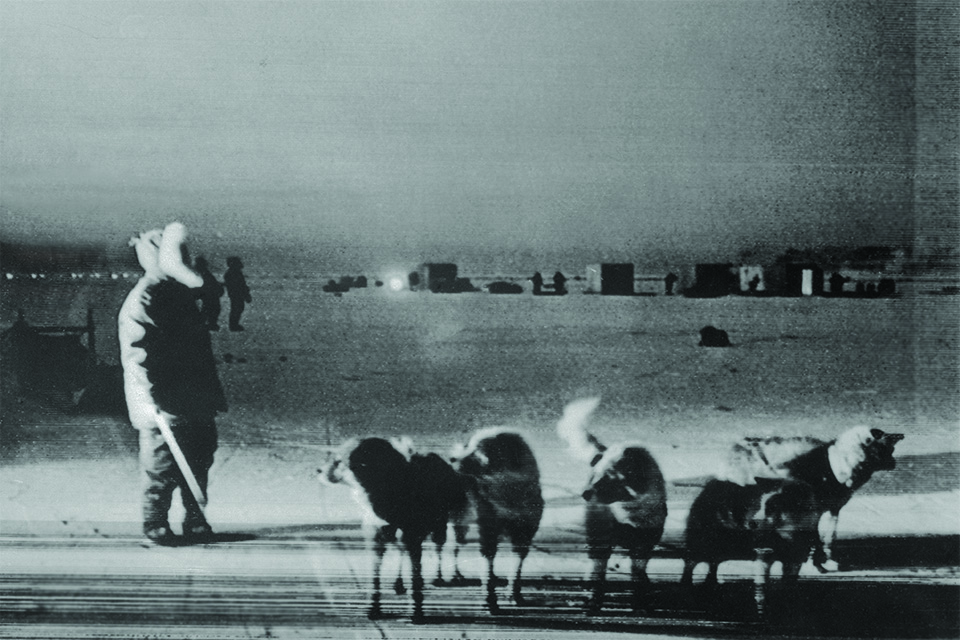
On any given day, between storms, from one to three dozen U.S. personnel and up to a dozen Inuits worked on the ice, while another 25 to 250 personnel at the base transported, monitored, identified and containerized plane parts and contaminated snow and ice. Project Crested Ice ultimately drew in about 565 Americans and 85 Danish citizens, who searched some 30 square miles of sea ice for debris and radioactivity. By April 10, Danish and Air Force crews had completed the cleanup operations on the sea ice. Afterward, Thule AFB personnel spread “carbonized sand” over 6.2 acres of slightly contaminated sea ice to accelerate springtime melting and to bind the remaining fuel and radionuclides so they would sink rather than wash onto the beach.
Denmark required the U.S. government to remove all of the radioactive debris and contaminated snow and ice from Greenland. Thule AFB ultimately amassed an incredible collection of waste, including 71 25,000-gallon tanks filled with cleanup debris and contaminated snow and ice. Alongside were 14 large “engine containers,” 192 drums of aircraft debris and 268 1,800-gallon tanks filled with contaminated liquid. The largest piece of aircraft recovered was only desk-sized, though larger forged pieces, such as landing gear struts, remained at the bottom of Bylot Sound. The Air Force flew the recovered hydrogen bomb fragments to three facilities in the U.S. Spring ice melt allowed U.S. Navy cargo ships to remove the melted ice and snow to the Savannah River Plant in South Carolina.
In August the research submersible STAR III arrived at Bylot Sound, ostensibly to document the debris that had fallen through the sea ice, but more important to search for and, if possible, retrieve the still-missing uranium-filled fourth secondary. While the three Air Force submariners did identify during their 11 dives several small pieces that had been parts of one or more of the H-bombs, along with thousands of plane fragments, they did not find the missing secondary. They concluded that it had settled into an 800-foot-deep unsurveyed portion of the sound.
Of the four H-bombs, cleanup crews recovered most of the uranium from three secondaries, but none from the fourth. Crews could not recover any of the plutonium, uranium and tritium that burned and blew away in the initial fire, nor a considerable amount of radioactive material that either sank or refroze in the ice at the impact site. In the final accounting, about 35 percent of the total plutonium (4.8 of 13 pounds) and at least one-third of the total uranium (roughly 19 of 53 pounds) was lost, mostly from the weapon in the lower left of the bomb bay, which likely detonated first.
As a consequence of this Broken Arrow event, SAC discontinued Chrome Dome and instead kept its bombers on high alert, with engines cold on the pad. The Air Force continued to send B-52s up to Thule on Hard Head missions, but with empty bomb bays. D’Amario rejoined those crews on at least one mission, though presumably with no extra seat cushions. Boeing provided alerts to crews to warn of the high heat from the air bleed system. The national laboratories also began to design nuclear weapons with insensitive high explosives to prevent reoccurrence of this kind of catastrophe. To this day deep in Bylot Sound, classified and mostly unrecognizable fragments of hydrogen bombs remain buried in the soft sediment.
Timothy Karpin and James Maroncelli are the authors of The Traveler’s Guide to Nuclear Weapons: A Journey Through America’s Cold War Battlefields, available at atomictraveler.com. Further reading: Hangar Flying, by Alfred J. D’Amario; and Thule: Nuclear Weapon Accident Near Thule Greenland, by John Taschner and James Oskins.
This feature appeared in the November 2017 issue of Aviation History Magazine. Subscribe today!

